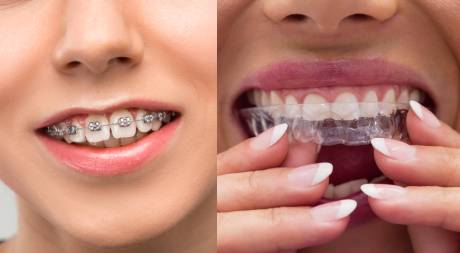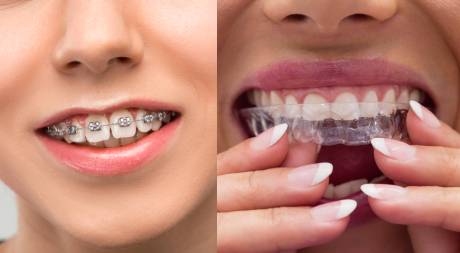 24 Sep 2021
24 Sep 2021 Invisalign VS Braces Explained
 Braces or Invisalign? When the question is about making the right choice, the work might be even harder than it seems. “Which one is better and efficient? Which would be more cost-effective?” are the questions that inevitably cross our minds while we go through the process of settling with the one that we might deem the “best suited” for ourselves.
Braces or Invisalign? When the question is about making the right choice, the work might be even harder than it seems. “Which one is better and efficient? Which would be more cost-effective?” are the questions that inevitably cross our minds while we go through the process of settling with the one that we might deem the “best suited” for ourselves.
When it comes to orthodontic treatment, patients have a lot of questions. But in the end, they want to choose the treatment that will do the best job for their particular situation. Invisalign and metal braces are usually the most popular options for orthodontic treatment. But should you need to choose one, do you know the difference?
Your orthodontist can help you make an informed decision based on the information you’ve personally worked on. Invisalign isn’t always the best option for some patients, which is why getting expert advice from your Orthodontist is essential.
If you’d like to learn more about the differences between Invisalign and Braces, then more information awaits you in this article.
Treatment basics
Both braces and Invisalign are intended to straighten teeth while also improving your smile and overall dental health. Metal braces are made up of a metal bracket that is adhered to each tooth and is then connected by a wire that is clamped in a way that gradually moves each tooth into its proper position. The wire is held in place with small rubber bands in a range of colors.
Through a series of clear, tailor-made, and removable appliances called aligners, Invisalign straightens your teeth without the use of braces or other metal equipment. Though traditional metal braces are an old and reliable process and the Invisalign system is new, nevertheless, its effectiveness is no less than the braces themselves.
Metal braces
In general, braces made of metal are the most popular and commonly utilized. While braces and Invisalign have certain dissimilarities, the former is not removable. When it comes to correcting complex difficulties, they’re far more effective than Invisalign.
In the case of braces, the average treatment length ranges from eighteen months to three years. However, you’ll generally notice improvements within a few days. This can boost your self-confidence and encourage you to stick with it.
Braces might be intimidating for some people because of the amount of maintenance they require. Foods to avoid are numerous; brackets and wires need to be adjusted periodically, and flossing can be a challenge. However, there are several products available to make your dental hygiene regimen easier. Most problems can also be fixed at home using easy tricks.
Patients with traditional braces will have follow-up appointments every 4 to 8 weeks. Dentists will modify the bracket bands and the wire during these appointments. Normally, the process will take around 30 minutes.
After each visit, there may be some residual soreness, but it should disappear within a day or two. Avoid skipping these vital appointments at any cost. Your previous treatment plan will most likely be extended if you do this.
Invisalign
The fact that Invisalign aligners are removable and invisible is what makes them so popular. Aligner removal is possible for eating, brushing, and flossing as well as for special occasions when you don’t want your treatment to interfere with daily life. They are removable, so you may eat and drink whatever you want, without bothering about breaking a bracket or loosening a wire.
Depending on the treatment plan, your therapy could comprise as few as 12 trays or as many as 48.
You will be shown by the dentists how to utilize them and when. However, this can vary from patient to patient. The average treatment length generally is between six and eighteen months. Patients must be willing to wear their aligners for the prescribed 20-22 hours a day since any deviation from this schedule might delay treatment duration and increase costs.
You’ll be able to see how far you’ve progressed with Invisalign at each visit, which takes place every 4-6 weeks. Aligners are changed every 1-2 weeks to keep up with tooth movement. In the process of straightening, this is a crucial step. Unscheduled visits or failure to replace aligners when they are due can cause unnecessarily prolonged treatment.
Which one is better? Invisalign or Braces
Using braces or Invisalign for orthodontic dental treatment has more advantages rather than just teeth straightening. They can even be used to repair biting problems, which generally require specialized diagnostic and treatment methods.
The use of braces or Invisalign is just one of the various orthodontic treatments that dental experts employ to straighten their patients’ teeth. As a result of this, they straighten teeth so that they are in the correct place, appear better, and function properly. They transform your smile at once with Invisalign’s clear plastic aligner tray system. Traditional braces, on the other hand, use metal wires to reposition or position the teeth in the most perfect way.
As long as the tooth movements aren’t too difficult, Invisalign is a good option to consider. An ideal pair of computer-generated, clear trays should be worn around the clock and replaced every two weeks. The shelf life of particular trays might range from six months to a full year or more.
In order to keep the teeth from slipping back, they require some type of retention. As an added bonus, the trays are virtually unnoticeable as its name suggests. Braces can be embarrassing for some people. For people who want straight teeth, but yet feel comfortable in social situations, they can help with that as well. Moreover, an Invisalign never affects your speech.
Furthermore, Invisalign is more effective for cosmetic reasons than for functional ones. So many people still prefer dental braces, especially those with complicated dental problems.
Whereas, brackets on dental braces tend to run along a wire that is attached to the teeth. In order to attach the dental braces to the teeth, an orthodontist or other certified dental practitioner must be present to do so. The braces’ wires and brackets are forced on the patient’s teeth. There is a small amount of mobility that can be used to align and straighten the teeth.
Even the most difficult cases of misalignment can be corrected with dental braces. These are functional as well as beautiful braces. These can be used to close gaps and straighten teeth.
For more complex cases, dental braces are the best option
As far as teeth straightening are concerned, dental braces have many advantages over Invisalign. Braces are usually made of colorful metal or resin brackets and are connected to the teeth’ surfaces. In addition, braces include a wire that passes through them and secures them to the skin. As opposed to Invisalign, dental braces are fixed in place.
When compared to an Invisalign treatment, braces are functional and work well to repair complex dental conditions, unlike Invisalign. Also, braces should close gaps and straighten teeth faster than Invisalign.
Considering the process of shifting misaligned teeth, braces, according to patients, work in a pretty short time. Besides straightening teeth, the usage of these dental materials helps to correct bites and create an appealing and healthy smile as well. This has a major impact on the patient’s self-confidence. Malocclusion (crooked or crowded teeth) and poor bites can also be corrected with dental braces.
In cases where the patient’s bite is irregular, braces might be used to bring out the patient’s best smile. By correcting this problem immediately, the patient’s smile and oral health can both be improved.
Inability to fix an incorrect bite or other dental disorders that can be treated with braces is advantageous because it can lead to oral health complications. Clearly, dental braces are effective in treating a variety of dental issues.
Therefore, which one is better than which can be determined only by determining the specific need in each case and deciding which one will meet that need in the best way for the patient.
Which has the best appearance?
With Invisalign’s superior aesthetics, braces will always lose. When compared to traditional metal braces, Invisalign is virtually invisible. Unlike metal braces, Invisalign aligners are made of clear plastic. Metal braces can be fun for some kids, but Invisalign is preferred by most children and adults. Those who want their teeth straightened in a discreet manner should opt for Invisalign.
Choose the one which comforts you
Straightening your teeth isn’t usually the most pleasant process. With braces or Invisalign, moving your teeth can be uncomfortable. Since Invisalign puts less pressure on the teeth, it is more comfortable than traditional braces. Braces can also have sharp edges that can sever the inner lip and tongue if they are worn incorrectly.
For those who participate in sports, metal braces might pose a safety risk if they come into touch with another person or object. Braces or Invisalign become more pleasant with time as people become accustomed to them.
Which one is more convenient to use?
Convenience is a factor that can be weighed against both traditional braces and Invisalign braces. You can save time by not having to remove your braces, yet they can restrict you from eating certain meals.
You can eat hard or sticky foods while wearing Invisalign, but remember to remove the trays, and storing them safely, which is often forgotten about.
Invisalign may not be the greatest solution if you or your child is prone to misplacing items. Invisalign trays must be removed before eating and reinserted thereafter, which might be difficult in social circumstances.
How to clean and care?
Maintaining good oral hygiene should be a priority, regardless of whether you’re wearing braces or Invisalign. As a general rule, cleaning braces is easier because you can brush and floss as usual. To clean the metal, you may need a smaller brush if there is food caught in it.
Even though brushing and flossing are the same when using Invisalign, it does take some extra effort to keep the aligner trays clean. When you dine, you should clean your trays every time you eat. When rinsing and brushing the Invisalign aligners, you can use warm water or an Invisalign cleaning solution.
Even when you are at home, cleaning the Invisalign tray’s crevices can be trouble. And without proper cleaning, bacteria or solid food can accumulate. Remember to brush and floss when you have braces or Invisalign!
The takeaway
In the end, the choice between Invisalign and braces comes down to personal preference. As a result, to make the best decision for yourself or your child, you should consider the categories listed above. You should also consult with an orthodontist to determine if you qualify for Invisalign.
You may not be eligible for this type of treatment if you fall into certain categories. You don’t have to wait any longer to change your smile and start feeling more confident. Maintain good oral hygiene and keep in touch with your orthodontist if you have questions, no matter what you decide.
